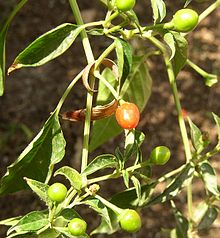Capsicum annuum var. glabriusculum
| Capsicum annuum var. glabriusculum | |
|---|---|
 |
|
| Scientific classification | |
| Kingdom: | Plantae |
| Clade: | Angiosperms |
| Clade: | Eudicots |
| Clade: | Asterids |
| Order: | Solanales |
| Family: | Solanaceae |
| Genus: | Capsicum |
| Species: | C. annuum |
| Variety: | C. a. var. glabriusculum |
| Trinomial name | |
|
Capsicum annuum var. glabriusculum (Dunal) Heiser and Pickersgill |
|
| Synonyms | |
| Capsicum annuum var. glabriusculum | |
|---|---|
| Heat |
|
| Scoville scale | 50,000–100,000 SHU |
Capsicum annuum var. glabriusculum is a variety of Capsicum annuum that is native to southern North America and northern South America. Common names include chiltepin, Indian pepper, chiltepe, and chile tepin, as well as turkey, bird’s eye, or simply bird peppers, due to their consumption and spread by wild birds. Tepin is derived from a Nahuatl word meaning "flea". This variety is the most likely progenitor of the domesticated C. annuum var. annuum. Another similar-sized pepper 'Pequin' (also called 'Piquin') is often confused, the Tepin fruit is round to oval and the Pequin is oval with a point, and the leaves, stems and plant structure are very different on each plant.
Chiltepin is a perennial shrub that usually grows to a height of around 1 m (3.3 ft), but sometimes reaches 3 m (9.8 ft). and in areas without hard frost in winter, plants can live 35–50 years.
The tiny chili peppers of C. a. var. glabriusculum are red to orange-red, usually slightly ellipsoidal, and about 0.8 cm (0.31 in) in diameter. Some strains of tepin peppers are much closer to perfectly round when fresh. If a tepin pepper is dried, it appears quite round even if it was slightly ellipsoidal when fresh. Tepin peppers are very hot, measuring between 50,000 and 100,000 Scoville units.
Some chile enthusiasts argue that the tepin can potentially be hotter than the habanero or red savina, supported with the numbers reported from Craig Dremann's Pepper Hotness Test scores.
However, since this pepper is harvested from wild stands in the Mexican desert, the heat level of the fruit can vary greatly from year to year, depending on the amount of natural rainfall that occurs during the time the fruits are forming. During drought years, fruit heat levels can be weak, and during normal rainfall years, the highest heat levels are produced. Also there is a large variation between the heat levels of the green fresh fruit (which are pickled in vinegar), red-ripe fresh fruit, dried whole fruit and dried fruit with the seeds removed, and their heat levels are arranged from mildest to hottest in that order.
...
Wikipedia
